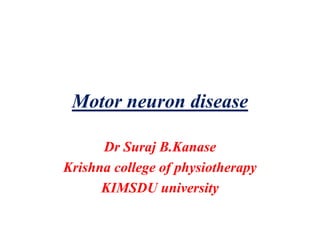
Motor Neuron Disease
- 1. Motor neuron disease Dr Suraj B.Kanase Krishna college of physiotherapy KIMSDU university
- 3. Learning objectives 1. Definition and types, 2. Clinical features of various types 3. Pathology of MND 4. Diagnosis 5. Treatment
- 4. Motor neuron disease is a progressive degeneration of motor neurons causing amyotrophy, weakness and corticospinal signs in different combinations. The cause of motor neuron disease is usually not known however in some cases hereditary factors may be considered. Motor neuron disease manifests in different forms depending upon site of lesion, clinical presentations and pathology.
- 5. 1. Amyotrophic lateral sclerosis : • Begins at around 40-50 years of age. • Men are more affected . • About 5 percent cases are predisposed by hereditary factors. • It has mixed presentation of UMN and LMN symptoms which is the diagnostic criteria.
- 6. Clinical presentation : • Mostly begins as asymmetrical and unilateral involvement. • The person experiences difficulty in precision activites of hand. • There is weakness, wasting and cramping of the small muscles of hand. • In the later stages the disease becomes symmetrical and there is bilateral involvement.
- 7. • The lower extremities shows signs of spasticity with brisk reflexes and positive babinski sign. • Wasting is primarily of interossei and lumbricals as compared to long flexors giving rise to skeletal hand appearance. • The sphincter functions and abdominal reflexes remain spared in most cases.
- 8. 2. Progressive muscular atrophy : • Male population are involved more at a ratio of 4:1 • There is strictly LMN type of presentation beginning in the hands. • There is gross weakness, wasting, fasiculations in the hand and then the disease progress to involve the other parts of the extremities as well as the lower limbs. • In the lower limbs peritibial muscles are involved and the patient ends up having a “ foot drop”.
- 9. • Unlike amyotrophic sclerosis this disease progresses very gradually up to 10 to 15 years and there is no signs of corticospinal tract involvement. 3. Progressive bulbar palsy : • In this condition there is involvement of motor nuclei in the lower brainstem. • There is primarily involvement of bulbar muscles, patient suffers from dysphagia, dysarthria etc.
- 10. • Food particles get stuck to one corner of the mouth as muscles of mastication and deglutition are affected. • Weakness of the pharyngeal muscles causes improper pushing of food particles into esophagus giving rise to choking. • Fibrillation of tongue is very common. • In later stage there may be UMN type of involvement and jaw jerk may be exaggerated giving rise to strong blinking of eye and wide opening of the mouth that gives rise to “ Bull Dog” appearance.
- 11. • Death in this condition is mainly due to respiratory failure and whole disease progresses within a span of 2 years. 4. Primary lateral sclerosis: • This type of MND may also have hereditary predisposition and there is only UMN type of presentation. • There is involvement of corticospinal and corticobulbar pathways. • There is no fasciculation and amyotrophy in this condition
- 12. Pathology of MND • Disease affects primarily UMN ( pyramidal cells, corticospinal tract and corticobulbar fibers) and the LMN (cranial nerve nuclei in brainstem and anterior horn cell). • The affected neuron shrinks and they are covered with a thick layer of pigmented lipids and this process is called as lipofuscin. • Because of affection of motor neurons there is severre wasting and weakness of corresponding muscles.
- 13. Diagnosis The diagnosis can be made on three typical features: 1. Involvement restricted to UMN and LMN. 2. Whether there is involvement of other neurons apart from motor neurons (there is no sensory loss in MND) 3. Presence of conduction block in electrophysiological study will rule out chances of this condition.
- 14. Treatment 1. False hope should never be given to the patient. As the disease has a poor prognosis the patient is made to understand in the correct fashion regarding his illness and the precaution he needs to take. 2. Gentle active exercises should be given in order to maintain the rabge of motion and as well as to maintain the strength. Spasticity of some muscles do help the patient to maintain functional independency for a long time.
- 15. 3. Passive range of motion and gentle stretching also helps in maintaining the range as well maintain the circulation in the area. 4. Self stretching is taught to the patient to get rid of the cramps which he is likely to get.no form of vigorous restricted exercises should be given as they give rise to increase fatiguability and cramps which in longer run can cause more damage than benefit to the patient. 5. Patient should be kept as mobile as possible through walking or standing for as long as possible.
- 16. 6. Secondary complications in the form of pressure sores and contractures should be avoided. Maintenance of chest expansion is of utmost importance to avoid respiratory complications. 7. Light weight orthosis may be given to gain stability in the joints that may help the patient in being functionally independent. Knee orthosis, cockup splint are commonly used. 8. Proper positioning of the patient is necessary in order to avoid difficulty in maintaining upright position. Assistance of pillows is necessary for providing comfortable position
- 17. 9. Psychological counseling is very essential to prevent the patient from going into a state of depression and keep his motivation level high.
- 18. Thank you